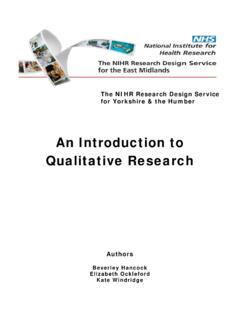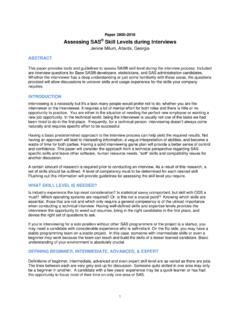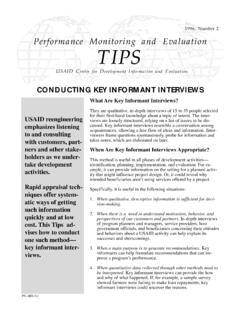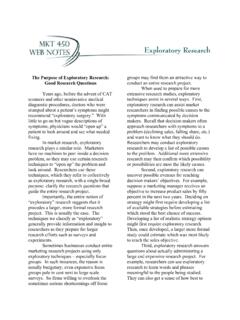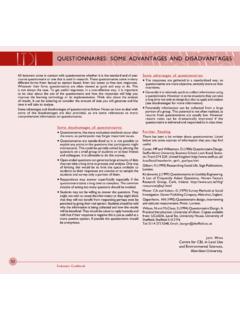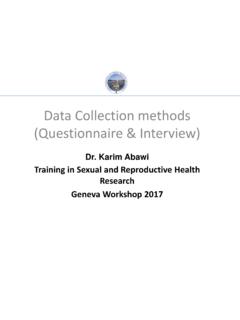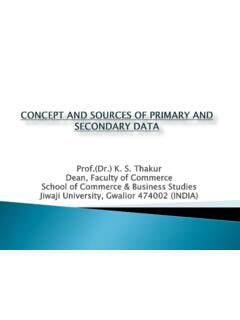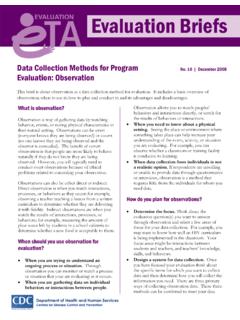Transcription of Using Interviews in a Research Project
1 Using Interviews in a Research Project Author Nick Fox The NIHR Research Design Service for Yorkshire & the Humber The NIHR RDS for the East Midlands / Yorkshire & the Humber 2009 2 Using Interviews This Resource Pack is one of a series produced by The NIHR RDS for the East Midlands / The NIHR RDS for Yorkshire and the Humber. This series has been funded by The NIHR RDS EM / YH. This Resource Pack may be freely photocopied and distributed for the benefit of researchers. However it is the copyright of The NIHR RDS EM / YH and the authors and as such, no part of the content may be altered without the prior permission in writing, of the Copyright owner.
2 Reference as: Fox, N: Using Interviews in a Research Project The NIHR RDS for the East Midlands / Yorkshire & the Humber 2006 Dr Nick Fox School of Health and Related Research , University of Sheffield Last updated: 2009 The NIHR RDS for the East Midlands Division of Primary Care, 14th Floor, Tower building University of Nottingham University Park Nottingham NG7 2RD Tel: 0115 823 0500 Leicester: Nottingham: The NIHR RDS for Yorkshire & the Humber ScHARR The University of Sheffield Regent Court 30 Regent Street Sheffield S1 4DA Tel: 0114 222 0828 Sheffield: Leeds: York: Copyright of The NIHR RDS EM / YH (2009) The NIHR RDS for the East Midlands / Yorkshire & the Humber 2009 2 Using Interviews Table of Contents Page 1.
3 4 2. Types of 5 3. interview 7 4. Locating and Selecting Respondents Who and How Many?.. 11 5. Getting Agreement to Undertake 14 6. Structuring the 15 7. Preparing for the 20 8. Methods of Recording 22 9. Conducting an Individual 24 10. Conducting a Focus Group 27 11. Sources of Error and Bias in 29 12. Handling and Analysing interview 32 13. 34 14. Answers to 35 15. 37 The NIHR RDS for the East Midlands / Yorkshire & the Humber 2009 3 Using Interviews 16. Further 37 The NIHR RDS for the East Midlands / Yorkshire & the Humber 2009 4 Using Interviews 1.
4 Introduction The interview is an important data gathering technique involving verbal communication between the researcher and the participant. Interviews are commonly used in survey designs and in exploratory and descriptive studies. There is a range of approaches to interviewing, from completely unstructured in which the participant is allowed to talk freely about whatever they wish, to highly structured in which the participant responses are limited to answering direct questions. The quality of the data collected in an interview will depend on both the interview design and on the skill of the interviewer.
5 For example, a poorly designed interview may include leading questions or questions that are not understood by the participant. A poor interviewer may consciously or unconsciously influence the responses that the participant makes. In either circumstance, the Research findings will be influenced detrimentally. It is often assumed that if one is clinically trained and used to dealing with patients, that this is sufficient training to carry out Interviews with patients and others for Research purposes.
6 Although there are some areas of overlap in terms of the basic communication skills required, it should be acknowledged that for Research some different skills are required. The context is also important, since in a clinical setting, there is a particular relationship between a patient and a clinician. It is possible that in this routine setting the patient would not be prepared to answer all the questions in a completely honest manner. So it may well be worthwhile thinking about the interview from the respondent s point of view and considering carefully who would be the most appropriate person to conduct the interview and in what setting.
7 There may be a conflict of roles, for example, therapeutic versus Research ; or even an unconscious adoption of roles that could affect the quality of the data collected. LEARNING OBJECTIVES Having successfully completed the work in this pack, you will be able to: Describe the features of, and differences between structured, semi-structured or unstructured interview . Summarise the advantages and disadvantages of face-to-face and telephone Interviews , and of individual and group Interviews . Prepare for, and conduct an interview Working Through this Pack The study time involved in this pack is approximately 10 hours.
8 In addition to the written text, the pack includes exercises for completion. I suggest that as you work through the pack, you establish for yourself a reflective log , linking the work in the pack to your own Research interests and needs, and documenting your reflections on the ethnographic method. Include your responses to the exercises plus your own thoughts as you read and consider the material. You will find answers to the exercises at the end of the pack. The NIHR RDS for the East Midlands / Yorkshire & the Humber 2009 5 Using Interviews 2.
9 Types of interview The interview design and question phrasing will influence the depth and freedom with which a participant can respond. Some Interviews encourage lengthy and detailed replies while others are designed to elicit short and specific responses. The degree of structure imposed on an interview will actually vary along a continuum but it is useful to think of three main types: structured, semi-structured and unstructured. Structured or Standardised Interviews Structured Interviews enable the interviewer to ask each respondent the same questions in the same way.
10 A tightly structured schedule of questions is used and often the intention is to use a quantitative method of data analysis. In many structured Interviews , not only will the questions be set in advance, but the possible choice of answers also. Pre-coded responses are important to allow for comparison across all respondents. It is usual for all responses to be noted or written down on the questionnaire. By minimising the number of open-ended responses, the amount of time required for coding and content analysis is greatly reduced and often the data can be directly entered onto a computer for analysis.
